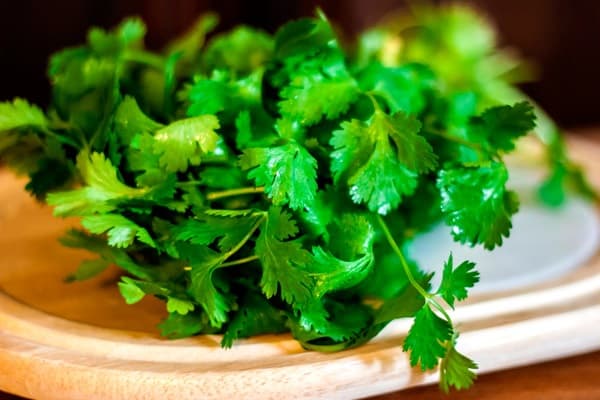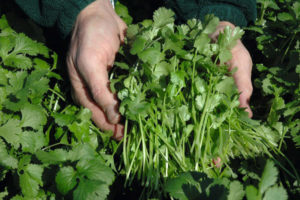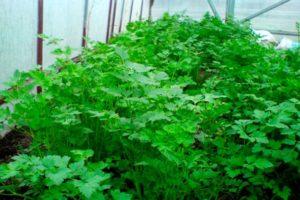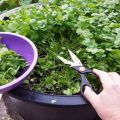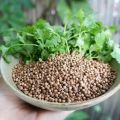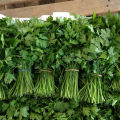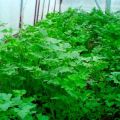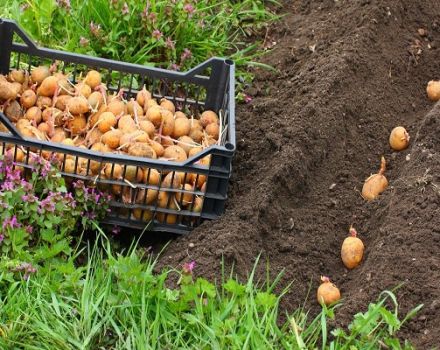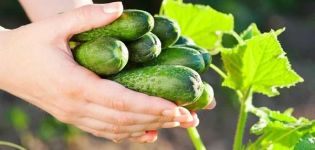Description of the best varieties of coriander (cilantro), useful properties and cultivation
Cilantro belongs to the annual herb and has a specific aroma. Due to its taste characteristics, the plant has become widespread in the culinary field. Using different varieties of cilantro can change the perception of a dish and bring innovation to familiar recipes.
Content
- 1 History of appearance in Russia
- 2 Description of the variety
- 3 Appearance
- 4 Chemical composition
- 5 Beneficial features
- 6 Where does it grow?
- 7 The nutritional value
- 8 Coriander spices
- 9 Benefit and harm
- 10 Types of cilantro
- 11 Growing
- 12 Care
- 13 Pests and diseases
- 14 Harvesting and storage
- 15 Coriander oil
- 16 Application
History of appearance in Russia
In Russia, coriander began to spread relatively recently. Initially, the plant settled on the territory of European countries in the western and central parts. For the first time, cilantro in the form of seeds along with anise was brought to Russia from Spain by Count Apraksin. Coriander seeds were distributed to the peasants of the village of Krasnoye, Voronezh province, for cultivation. Among the seeds of anise, there were coriander seeds that they wanted to destroy like a weed. Over time, cilantro plants were tasted and used as an aromatic spice.
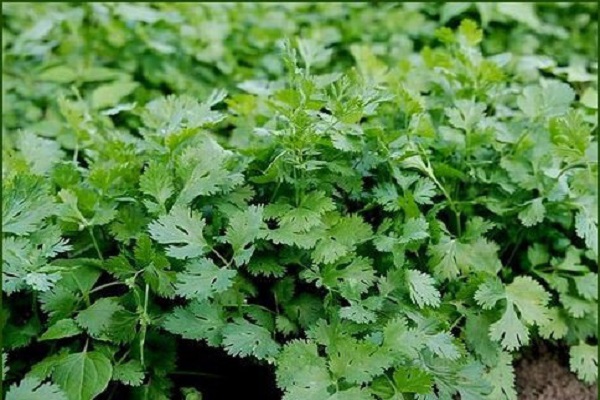
Description of the variety
Sowing coriander belongs to the herbaceous plants of the umbrella family. Despite its unusual aroma, the plant occupies a high position among all known spices. Among all essential oil crops grown in Russia, more than 75% of the area is coriander.
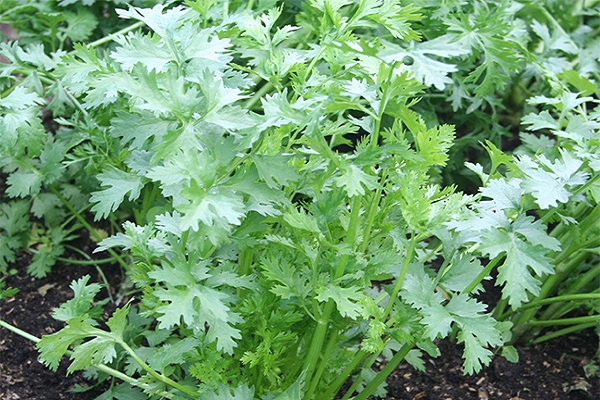
Appearance
The cilantro plant reaches a height of about 70 cm, has rounded stems branched from the base, an erect fusiform root and pinnately dissected leaves. At the edges, coriander leaves can be serrated or three-lobed. During the flowering period, the plant is covered with small pale pink or white flowers, folded into umbrellas. Ripe coriander fruits are dark achenes about 50 mm long. The globular coriander fruit of a brown-yellow color crumbles into two miniature spheres under pressure.
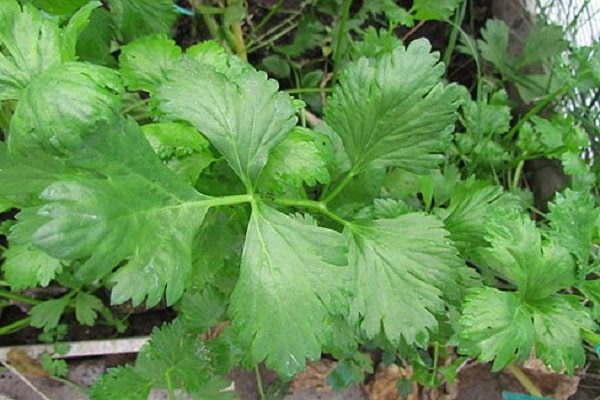
Chemical composition
Spicy coriander is a rich source of rutin, vitamins B and C, carotene, calcium, phosphorus and magnesium. Dry cilantro seeds have a cool pungency and a special aroma, since the drying procedure removes the trans-tricedenol-2 aldehyde from the plant.
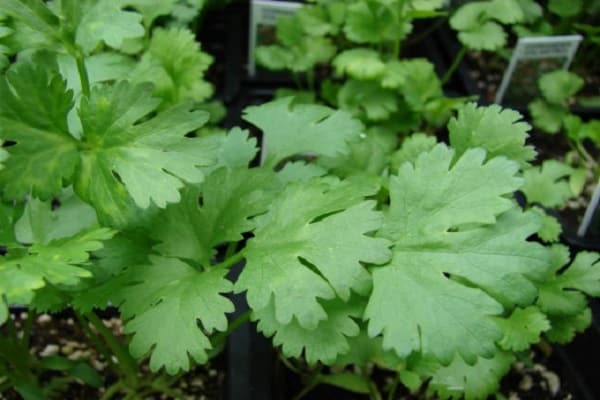
Beneficial features
The essential oil crop is used in various industries due to its beneficial characteristics. These include the following:
- cilantro enriches dishes with vitamins A and C;
- plant seeds help heal abrasions, reduce pain, stabilize the digestion process and liver function, help in the treatment of hemorrhoids and eliminate constipation;
- frequent consumption of coriander strengthens the immune system, has antiseptic and anti-inflammatory effects;
- greens improve appetite, activates the process of excreting toxins from the body, improves intestinal peristalsis, strengthens blood vessels and has a beneficial effect on blood composition;
- coriander lowers blood sugar, so it is recommended to include it in a regular diet for diabetes mellitus;
- essential oil culture helps to maintain your figure and fight overweight.
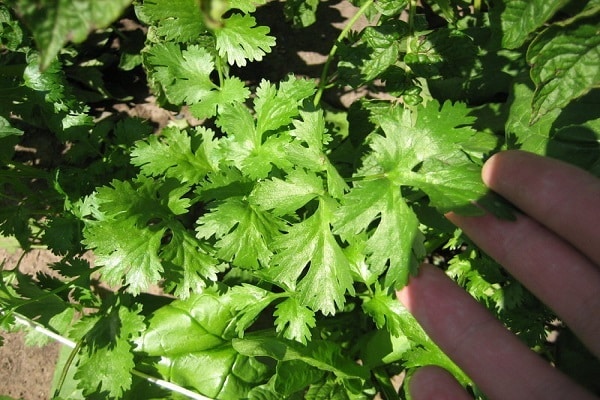
Where does it grow?
Any varieties of cilantro germinate better in sunny areas with fertile soils with a slightly acidic reaction. When choosing a place for planting coriander Avoid heavy, clayey soils that form a dense crust. You can plant coriander not only in the beds at the summer cottage, but also at home.
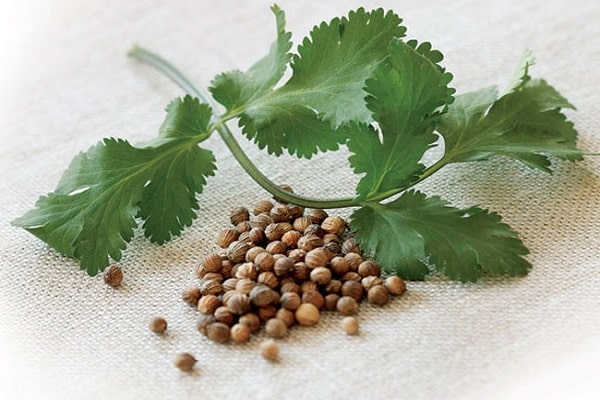
The nutritional value
100 g of cilantro contains 1% of the daily value of carbohydrates, 3% of protein and 1% of fat. The plant's carbohydrate content in grams is 3.7 g, which is about 52% of the total energy per serving, or 15 kcal. The total calorie content of coriander is 23 kcal.
The composition of the greens contains 0.9 g of sugar and 2.8 g of fiber. Coriander is free of trans fats and cholesterol. Of the fat-soluble vitamins, there are: beta-carotene, alpha-carotene, vitamins A, E and K. Also, coriander contains a number of macro- and microelements.
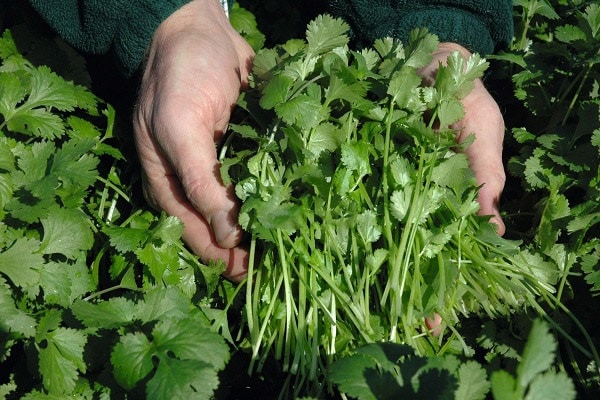
Coriander spices
Coriander is a common spice in Indian, Georgian and many other oriental cuisines. Coriander greens are included in recipes for pickles, baked goods, marinades and liqueurs. Due to its light taste, cilantro is ideally combined with other spices, for example, with basil, dill, chili, mint. The most popular combination of cilantro with cumin. Cilantro is also included in Indian masala and curry mix.

Benefit and harm
Coriander has a beneficial effect on the human body, it is used for depression, colds, diabetes. The essential oil contained in the spice has a strong anti-inflammatory and antiviral effect, and is excreted through the urinary system, healing the kidneys and bladder.
Despite the beneficial characteristics of coriander, increased consumption of coriander can lead to negative consequences. Greens are contraindicated for violations of the myocardium, thrombophlebitis and vascular diseases. Coriander can provoke an allergic reaction, so allergy sufferers should consume the product in small quantities. To include cilantro in the diet in a limited amount is also necessary for women during lactation or pregnancy.

Types of cilantro
There are a large number of varieties of coriander, which differ in taste, appearance, cultivation characteristics and other indicators. The most common among gardeners are the following types of cilantro:
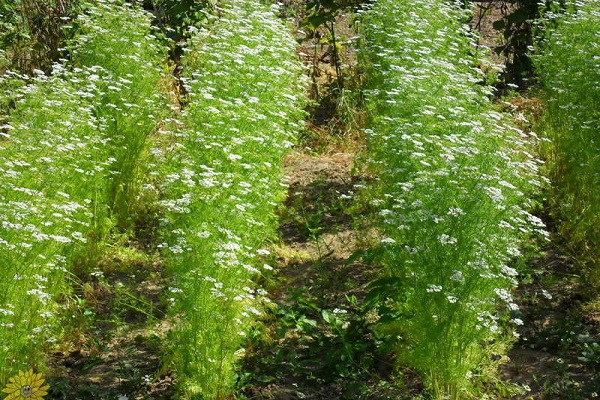
Vanguard
Recommended for use as salad greens and spices. A highly aromatic variety with a yield of 1.3–1.5 kg / sq. m.

Borodino
A mid-season coriander variety that ripens in 40–45 days. The weight of each plant is about 25-30 g. Productivity - 2.5 kg / sq. m.
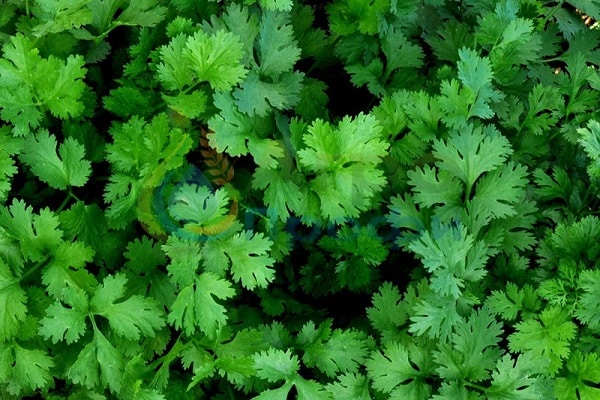
Kin-Dza-Dza
An upright plant with weak branching. A distinctive feature is the absence of anthocyanin coloration of the umbrella. Average yield - 1.5-1.6 kg / sq. m.
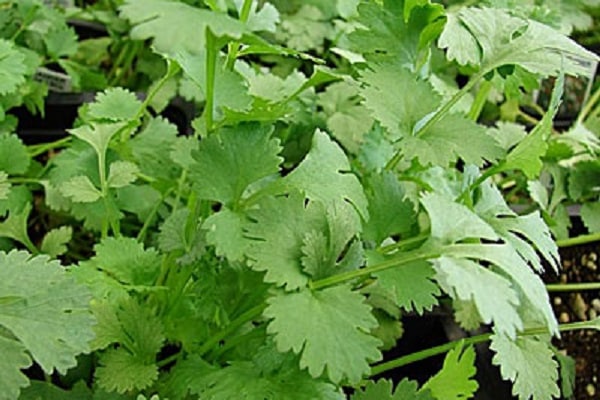
Market King
A plant variety with dense vegetation. Leaves are medium in size, rich green, smooth. The main advantages of the variety include high aroma and frost resistance. Productivity - 2.9 kg / sq. m.

Picnic
Fast growing cilantro species that ripens in 35 days. The leaves are large with jagged edges. Productivity - 3.2 kg / sq. m.

Charm
A late-ripening variety of coriander. The ripening period is 35 days. Small plants up to 40 cm high. Productivity - 3.2 kg / sq. m.
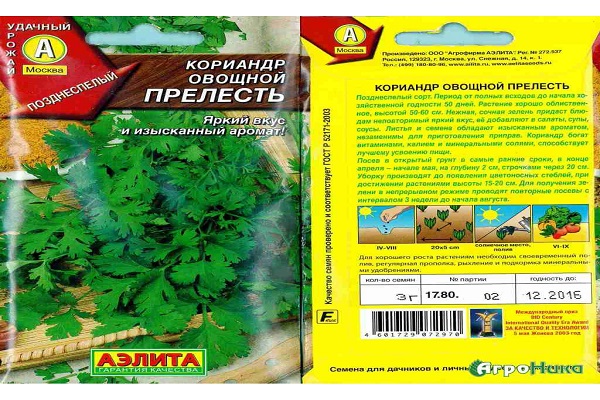
Chico
Well-leafed plants 50-60 cm high. Mid-season variety grows in 40-45 days. The yield is low - about 0.8-1.2 kg / sq. m.

Alekseevsky
Cilantro plant variety with smooth leaves and umbrella inflorescences. Plant height 85-90 cm. Productivity - 1.4 kg / sq. m.
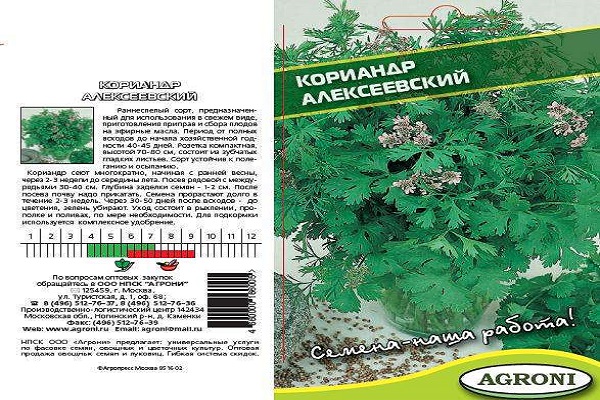
Ray
A compact variety of coriander weighing 20–40 g and about 50 cm high. The protein content is 9% and is twice the standard. The yield of the plant is 1.5-1.7 kg / sq. m.

Growing
Cilantro seeds are able to germinate even at low ambient temperatures starting from 6 degrees Celsius. Sowing the plant can be started in early spring by placing the seeds in open soil. Many gardeners plant the plant in several stages, leaving breaks of two weeks between them. It is allowed to start sowing coriander from March until the end of summer. Large seeds are sown in wide rows, leaving gaps of about 40 cm. The optimum depth for seed placement is 2–3 cm.
Early shoots of coriander tolerate late frosts, up to 7 degrees below zero. At the same time, for active growth and achieving a good yield of coriander, warm conditions are required - over 20 degrees Celsius.
Also, plant seedlings require sun, so when planting, dark areas should be avoided. In the absence of the sun, coriander bushes will stretch upward and will not produce dense vegetation. The land for cultivation must be fertile. Regardless of the variety, it is recommended to grow cilantro after cabbage, tomatoes, legumes and potatoes. Coriander propagates exclusively by seeds.
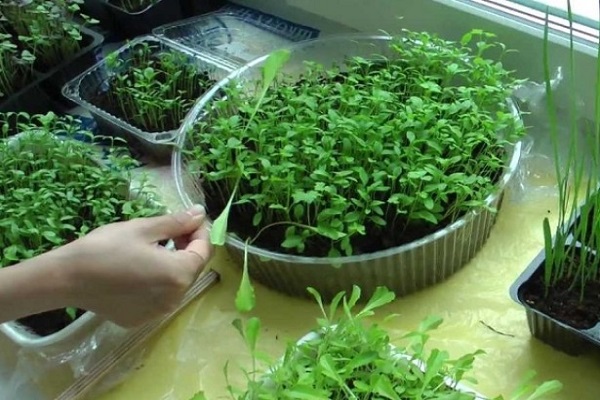
Care
No special care is required to ripen cilantro. It is enough to follow a few standard rules. First of all, abundant watering is important for the plant. The maximum need for watering occurs at the beginning of the growing season. Moderate watering is required during seed ripening and in the budding phase. Under the condition of long rains, the plants can not be watered, since excess moisture leads to the formation of rot.
In the first month of growing coriander, after each watering, you should carefully loosen the topsoil to improve aeration of the roots. Otherwise, the plants will significantly regress in growth. To build up dense vegetation, seedlings must be dived or thinned out at the stage of growth of the second leaf.
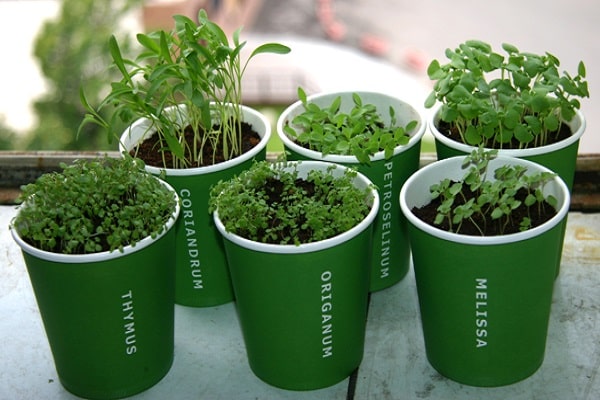
Pests and diseases
When growing coriander, there is a risk of encountering aggressive pests. The most dangerous is the coriander seed, gnawing holes in the fruit and causing significant damage to the crop. Once inside the fetus, the larva is activated and gnaws out the endosperm. If a pest is found in the beds, sowing of treated seeds and constant removal of weeds with further thorough digging are required. In addition to the seed eater, cilantro can be affected by the winter scoop, striped and umbrella bugs. The methods of dealing with them are similar, and as an additional measure, insecticidal fertilizers can be applied.
Among the diseases spreading to cilantro are ramulariasis and powdery mildew. Ramulariasis affects plants with excessive moisture and constant frost. Dark spots appear on the leaves of the crop, which are gradually covered with bloom. Over time, the affected plant dies. Powdery mildew is a fungal disease that quickly spreads from one plant to neighboring plants. The leaves of the diseased plants begin to turn yellow and fall off. The main measures to eliminate diseases of coriander are periodic feeding, following the rules of care and dressing the seeds.

Harvesting and storage
It is necessary to cut off the vegetation until the moment when the plant will lay flower stalks. If the buds have already appeared, then the greens will acquire an unpleasant taste and begin to taste bitter.When harvesting, it is recommended to leave a small petiole about 10 cm tall so that the cilantro can regrow. At the same time, the second wave of a full-fledged crop does not always grow, and in case of growth, the leaves become smaller. Harvesting coriander can take several days if the planting is uneven.
There are many ways to store cilantro. At home, greens retain their beneficial properties well when left in the refrigerator. The plant can be wrapped in foil or placed in a jar. The main thing is that the cilantro is sealed and air does not enter it. Leaving fresh cilantro in an airtight tray will keep it for about 8-10 days. If it is necessary to ensure long-term storage of coriander, it is better to use the methods of freezing, salting, drying and marinating.

If you need to leave fresh herbs for the winter, it is better to dry them. To do this, wash the plant well in water and completely wash off the dust and residues of the earth. First, the greens should dry out a little, after which they must be cut and spread on a paper sheet in a thin layer to dry completely. You can dry coriander in a dry, well-ventilated space or in an oven preheated to 40 degrees. Dried coriander should be placed in a glass jar or bag. When dry, the shelf life is about a year.
Using the freezing method, it is possible save cilantro in a rich green color. To do this, wash it, let it dry, put it in plastic bags or sealed containers and put it in the freezer. At a constant temperature of -18 degrees, coriander can be stored for a year. It is better to divide the cilantro into small portions so that you can get the right amount at any time.

Coriander oil
Herbal oil is widely used in aromatherapy, medicine and other industries. The benefits of organic coriander plant oil include antibacterial, soothing, choleretic and warming properties. By adding coriander oil to the daily diet, you can prevent the development of diseases such as gastritis, flatulence, dyspepsia. Natural cilantro oil has been proven to promote good appetite, glandular secretion and active gastric acid production.
As a preventive measure, it is recommended to consume 1-3 drops of coriander oil mixed with honey daily.
External application of the oil product helps in the treatment of joint pain in rheumatism or arthritis, as well as in the relief of convulsive symptoms and muscle spasms. Due to its anti-infectious effect, coriander oil is used for skin diseases and inflammation. The soothing effect of the oil relieves nervousness and improves the condition in stressful situations. The use of the product is recommended for general fatigue and decreased immunity.

Application
Medicinal properties of cilantro allow you to use it in traditional medicine. Infusion of cilantro seeds is extremely useful in the fight against colds. Dried herbs boiled in boiling water are used to eliminate bad breath. An alcoholic tincture of coriander can act as a sedative for nervous disorders and hysteria. To prepare the extract, green seeds are infused with vodka.
Sometimes tea is made from the seeds of a herbaceous plant, which can be drunk with a log during preparation for childbirth. It is better to start drinking the drink from the plant 2-3 weeks before the scheduled birth. At the same time, it is important to understand that during pregnancy, cilantro should be consumed in limited quantities, so as not to provoke probable allergic reactions.
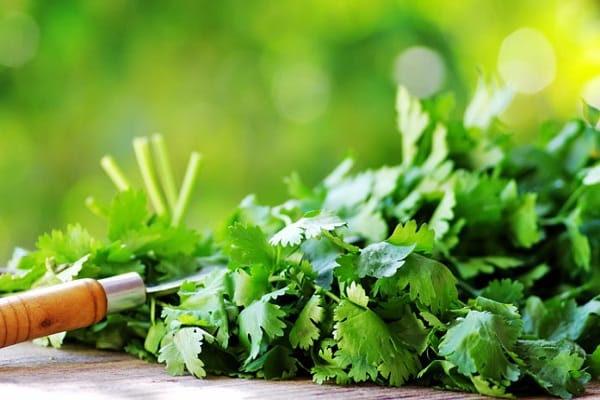
A decoction of coriander seeds is used to treat flu and sore throats. The presence of the antiseptic properties of the plant ensures the rapid healing of the patient and the sanitation of the oral cavity.In folk therapy, a decoction and infusion of coriander serves to treat eczema and dermatitis by applying compresses to problem areas of the skin. Washing with a solution of coriander makes the skin soft and velvety.
The plant is most widespread in cooking due to its special taste and bright aroma. The plant is used as a seasoning, spice or freshly harvested. Cilantro greens are added to food at the end of cooking or sprinkled on the finished dish to add a bright color and rich aroma. Coriander is suitable for combination with any vegetable salads, low-fat soups, fish and meat dishes.
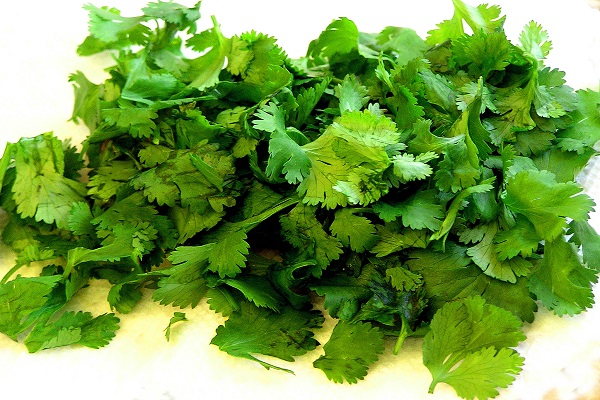
Coriander oil is actively used in cosmetology for the production of cleansing toners and skin care lotions. Cosmetic preparations based on it are used to eliminate acne and acne, to combat flaky skin and puffiness. Cilantro creams are an effective preparation for rejuvenating and maintaining healthy skin. Hair care products containing cilantro prevent early gray hair, eliminate dandruff and stabilize the secretion of the sebaceous glands.
You can also use cilantro for weight loss. The product is allowed to be consumed with any diet that provides for the presence of greens in the diet. Coriander stimulates an accelerated metabolism in the body. While adhering to a diet, it is recommended to have a snack with cocktails with vegetables and herbs. The presence of coriander in such cocktails gives strength and vigor, helps to withstand training and actively lose weight.
